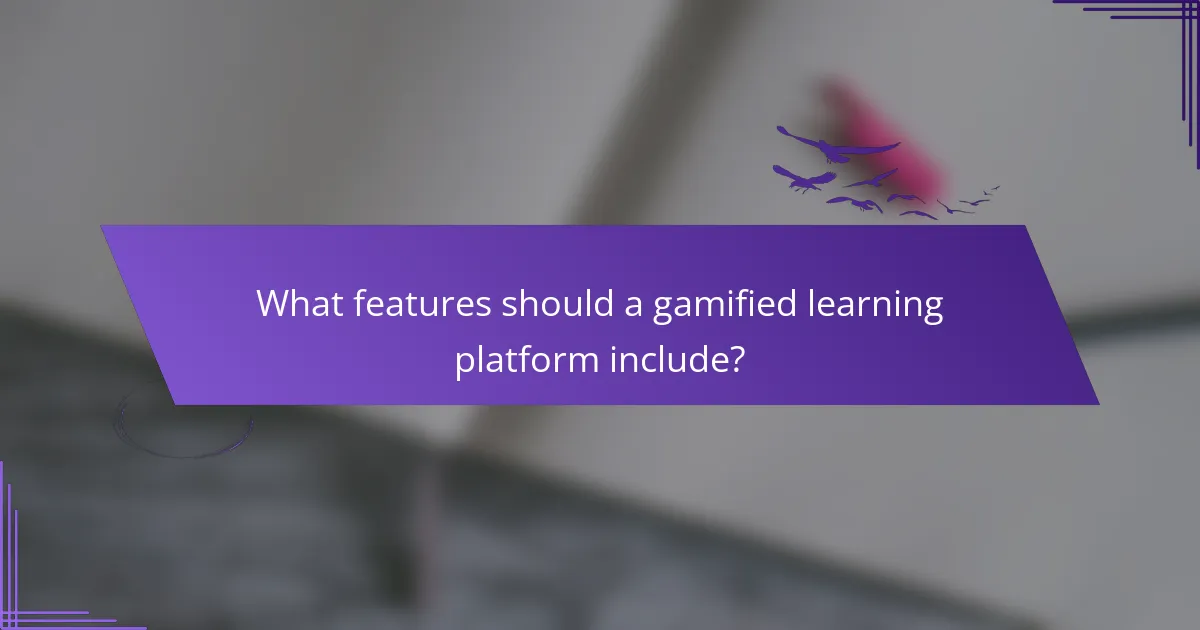Gamified learning platforms are revolutionizing corporate training by enhancing engagement and motivation among adult learners. By integrating game elements, these platforms create dynamic and personalized learning experiences that cater to individual needs, ultimately improving knowledge retention and overall effectiveness in training programs.

How does gamified learning benefit adult learners in corporate training?
Gamified learning enhances adult learners’ experiences in corporate training by increasing engagement and motivation while improving knowledge retention. By incorporating game elements into learning, organizations can create a more dynamic and interactive environment that caters to the unique needs of adult learners.
Increased engagement and motivation
Gamified learning captures adult learners’ attention by making training more enjoyable and interactive. Elements such as points, badges, and leaderboards encourage participation and foster a sense of achievement. This heightened engagement can lead to increased completion rates and a more positive attitude towards training programs.
To maximize engagement, consider incorporating challenges and rewards that align with learners’ interests and job roles. Tailoring content to reflect real-world scenarios can further motivate employees to participate actively.
Enhanced retention of information
Gamification can significantly improve information retention among adult learners by making learning experiences more memorable. Interactive elements, such as quizzes and simulations, encourage learners to apply knowledge in practical situations, reinforcing their understanding. Studies suggest that gamified learning can enhance retention rates by up to 50% compared to traditional methods.
To enhance retention, focus on spaced repetition and varied content delivery. Incorporating storytelling and real-life applications can help learners connect emotionally with the material, making it easier to recall later.
Improved collaboration and teamwork
Gamified learning fosters collaboration among adult learners by promoting teamwork through group challenges and competitions. This collaborative environment encourages communication and problem-solving, essential skills in corporate settings. When learners work together to achieve common goals, they build stronger relationships and enhance their collective skills.
To facilitate teamwork, design activities that require collaboration and encourage peer feedback. Utilizing team-based rewards can further motivate groups to work together effectively.
Personalized learning experiences
Personalization in gamified learning allows adult learners to progress at their own pace and focus on areas where they need improvement. By tailoring content to individual preferences and learning styles, organizations can create a more effective training experience. This approach not only increases satisfaction but also leads to better learning outcomes.
To implement personalized learning, use data analytics to track progress and adapt content accordingly. Offering choices in learning paths and allowing learners to set their own goals can enhance motivation and ownership of their learning journey.

What features should a gamified learning platform include?
A gamified learning platform should incorporate features that enhance engagement and personalization for users. Key elements include adaptive learning pathways, real-time feedback, social interaction tools, and reward systems that motivate learners and improve retention.
Adaptive learning pathways
Adaptive learning pathways tailor the educational experience to individual learners’ needs, preferences, and progress. By analyzing user performance, the platform can adjust content difficulty and learning routes, ensuring that each learner receives a customized experience that maximizes their strengths and addresses weaknesses.
For instance, if a user struggles with a specific topic, the platform can provide additional resources or alternative explanations. This approach not only enhances understanding but also keeps learners engaged by avoiding frustration from overly challenging material.
Real-time feedback and analytics
Real-time feedback and analytics are crucial for helping learners understand their progress and areas for improvement. Instant feedback on quizzes and activities allows users to adjust their learning strategies immediately, fostering a growth mindset.
Analytics can track user engagement and performance over time, providing insights into learning patterns. This data can be used by educators or corporate trainers to identify trends and tailor future training sessions, ensuring that content remains relevant and effective.
Social interaction tools
Social interaction tools facilitate collaboration and communication among learners, enhancing the overall learning experience. Features such as discussion forums, chat functions, and group challenges encourage users to share knowledge and support one another.
Incorporating social elements can lead to a sense of community, which is particularly beneficial for adult learners in corporate training environments. Engaging with peers can increase motivation and accountability, making learning more enjoyable and effective.
Reward and recognition systems
Reward and recognition systems are essential for motivating learners and reinforcing positive behavior. These systems can include points, badges, or certificates that acknowledge achievements and milestones, providing tangible incentives for progress.
For example, a platform might offer a badge for completing a series of modules or a leaderboard for top performers. Such recognition not only boosts individual morale but also fosters healthy competition among peers, driving further engagement and commitment to learning goals.

How to choose the right gamified learning platform for corporate training?
Selecting the right gamified learning platform for corporate training involves aligning the platform’s features with your organization’s learning objectives and user needs. Focus on usability, integration capabilities, and how well the platform can adapt to different learning styles.
Assess organizational learning goals
Begin by clearly defining your organization’s learning goals. Consider what skills or knowledge areas need improvement and how gamification can enhance engagement and retention. For instance, if the goal is to improve sales techniques, look for platforms that offer simulations and role-playing scenarios.
Engage stakeholders to gather insights on desired outcomes. This collaborative approach ensures that the selected platform meets the diverse needs of your workforce, whether it’s for onboarding, compliance training, or skill development.
Evaluate user experience and interface
User experience is crucial for the success of a gamified learning platform. A clean, intuitive interface encourages participation and reduces frustration. Look for platforms that offer customizable dashboards, easy navigation, and mobile accessibility, allowing learners to engage anytime, anywhere.
Consider conducting user testing with a small group of employees to gather feedback on the interface and overall experience. This can help identify any potential issues before full implementation and ensure that the platform resonates with your learners.
Consider integration with existing systems
Integration capabilities are essential for a seamless learning experience. Ensure that the gamified learning platform can easily connect with your current Learning Management System (LMS) and other tools used within your organization, such as HR software or performance tracking systems.
Evaluate the technical requirements and support offered by the platform provider. A well-integrated system can streamline data sharing and reporting, making it easier to track learner progress and outcomes across different platforms.

What are the best gamified learning platforms available?
The best gamified learning platforms combine engaging game mechanics with effective educational strategies to enhance learning experiences. These platforms cater to various needs, including corporate training and adult learners, by providing personalized and interactive content.
TalentLMS
TalentLMS is a versatile learning management system that integrates gamification features to boost user engagement. It allows organizations to create customized learning paths, incorporating elements like points, badges, and leaderboards to motivate learners.
When using TalentLMS, consider its user-friendly interface and mobile accessibility, which facilitate learning on-the-go. Additionally, its reporting tools help track learner progress, making it easier to identify areas for improvement.
EdApp
EdApp is a mobile-first learning platform that emphasizes microlearning and gamification to enhance retention. It offers features such as quizzes, interactive scenarios, and rewards to encourage participation and completion.
One of EdApp’s standout features is its template library, which allows users to create engaging content quickly. Companies should leverage its analytics to assess learner performance and adjust training strategies accordingly.
LearnDash
LearnDash is a WordPress-based learning management system that provides robust gamification options for course creators. It includes features like certificates, points, and leaderboards, which can be tailored to fit specific learning objectives.
For effective implementation, focus on creating engaging course content that utilizes LearnDash’s gamification tools. Regularly updating courses and incorporating feedback can enhance learner satisfaction and retention rates.

What are the challenges of implementing gamified learning?
Implementing gamified learning can be challenging due to various factors that affect employee engagement and acceptance. Key challenges include resistance to change, the need for proper training, and ensuring the gamification elements align with learning objectives.
Resistance to change among employees
Resistance to change is a common hurdle when introducing gamified learning platforms. Employees may be accustomed to traditional training methods and could view gamification as unnecessary or frivolous.
To address this resistance, it is essential to communicate the benefits of gamified learning clearly. Highlight how it can enhance engagement, improve retention, and make learning more enjoyable. Providing examples of successful implementations can also help alleviate concerns.
Involve employees in the development process by seeking their feedback and suggestions. This inclusion can foster a sense of ownership and reduce pushback, making them more likely to embrace the new approach.


